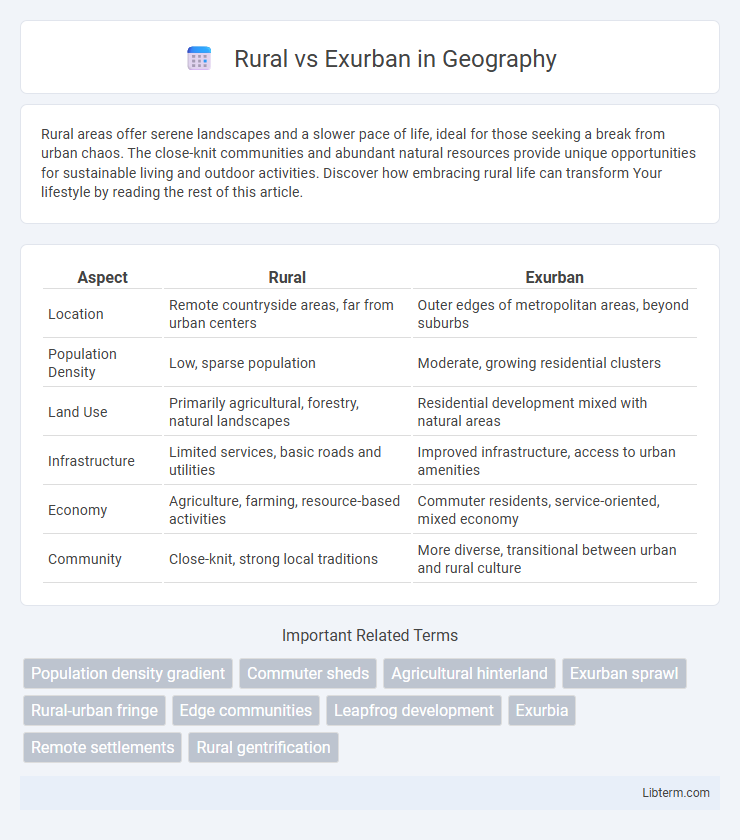Rural areas offer serene landscapes and a slower pace of life, ideal for those seeking a break from urban chaos. The close-knit communities and abundant natural resources provide unique opportunities for sustainable living and outdoor activities. Discover how embracing rural life can transform Your lifestyle by reading the rest of this article.
Table of Comparison
| Aspect | Rural | Exurban |
|---|---|---|
| Location | Remote countryside areas, far from urban centers | Outer edges of metropolitan areas, beyond suburbs |
| Population Density | Low, sparse population | Moderate, growing residential clusters |
| Land Use | Primarily agricultural, forestry, natural landscapes | Residential development mixed with natural areas |
| Infrastructure | Limited services, basic roads and utilities | Improved infrastructure, access to urban amenities |
| Economy | Agriculture, farming, resource-based activities | Commuter residents, service-oriented, mixed economy |
| Community | Close-knit, strong local traditions | More diverse, transitional between urban and rural culture |
Defining Rural and Exurban: Key Differences
Rural areas are characterized by low population density, expansive open spaces, and primarily agricultural or natural landscapes, often with limited access to urban amenities and infrastructure. Exurban regions lie beyond suburban zones, combining semblances of rural tranquility with increased residential development, better road connectivity, and proximity to metropolitan job centers. Key distinctions include population density, land use, and economic ties, where rural areas emphasize farming and natural resource reliance, while exurban zones exhibit commuter lifestyles and mixed-use land patterns.
Historical Development of Rural and Exurban Areas
Rural areas historically developed as agricultural hubs with low population density, centered on farming and resource extraction, shaping community structures and land use patterns. Exurban areas emerged later as suburban expansion extended beyond metropolitan boundaries, driven by increased automobile use and demand for housing outside urban centers while maintaining connectivity to city jobs. The shift reflects socio-economic trends, technological advancements, and changing lifestyle preferences influencing settlement and land development over time.
Population Density and Settlement Patterns
Rural areas typically exhibit low population density with dispersed settlements, characterized by large plots of land and agricultural use. Exurban regions show moderate population density with a mix of single-family homes and small clusters of development, often serving as commuter communities on the outskirts of metropolitan areas. Settlement patterns in exurban zones tend to be more organized and structured compared to the scattered, isolated dwellings common in rural settings.
Economic Drivers and Employment Opportunities
Rural areas primarily rely on agriculture, forestry, and small-scale manufacturing as key economic drivers, with employment opportunities often concentrated in farming, resource extraction, and local small businesses. Exurban regions benefit from a mix of rural industries and access to urban job markets, offering residents employment in both traditional rural sectors and suburban professional services or commuting positions. These economic dynamics create distinct labor markets, where rural zones face limited job diversity while exurban areas experience more varied employment options linked to metropolitan economic growth.
Infrastructure and Accessibility
Rural areas often face limited infrastructure including fewer paved roads, less reliable public transportation, and reduced internet connectivity, impacting overall accessibility. Exurban regions typically benefit from better road networks and closer proximity to urban centers, facilitating greater access to essential services and commuting options. The infrastructural gap significantly influences economic opportunities and quality of life between rural and exurban communities.
Housing Styles and Land Use
Rural areas predominantly feature traditional farmhouses, barns, and mobile homes with large plots of open land used for agriculture, forestry, or natural conservation. Exurban regions display a mix of suburban-style single-family homes, often on larger lots than typical suburbs, blending residential development with preserved natural spaces or small-scale farming. Housing density in exurbs is higher than rural zones, reflecting a transition toward commuter communities while maintaining extensive green buffers and limited commercial infrastructure.
Community Culture and Social Dynamics
Rural communities often exhibit close-knit social dynamics characterized by multigenerational ties, shared traditions, and strong local engagement in agriculture or natural resource-based economies. Exurban areas blend suburban commuters' lifestyles with a desire for space, fostering diverse social networks but often lacking the deep-rooted community culture found in rural regions. The shift from agrarian-based economies in rural zones to mixed residential and commercial developments in exurbs reshapes community interactions, emphasizing individuality alongside emerging neighborhood associations.
Environmental Impact and Land Conservation
Rural areas typically maintain extensive natural habitats and biodiversity due to lower population density and less infrastructure development, which supports greater land conservation efforts. Exurban regions often experience fragmented ecosystems as suburban sprawl introduces roads, housing, and commercial zones that disrupt wildlife corridors and increase pollution. Sustainable land-use planning and green infrastructure in both settings are crucial for minimizing environmental degradation and preserving ecological balance.
Challenges Facing Rural and Exurban Communities
Rural and exurban communities face significant challenges including limited access to healthcare, inadequate infrastructure, and lower economic opportunities compared to urban areas. Transportation barriers and broadband connectivity gaps exacerbate social isolation and hinder educational and employment growth. Addressing these issues requires targeted investment in infrastructure, healthcare services, and economic development programs tailored to the unique needs of rural and exurban populations.
Future Trends: Growth, Migration, and Policy
Rural areas are projected to experience moderate population growth driven by remote work trends and affordable housing, while exurban regions are expected to see faster expansion due to their proximity to metropolitan centers and increasing commuter patterns. Migration flows show a shift as younger families and retirees choose exurban locations for balanced access to urban amenities and open space, influencing infrastructure and public service demands. Policy initiatives targeting sustainable development, broadband expansion, and transportation investments will play critical roles in shaping future growth and livability in both rural and exurban communities.
Rural Infographic

 libterm.com
libterm.com